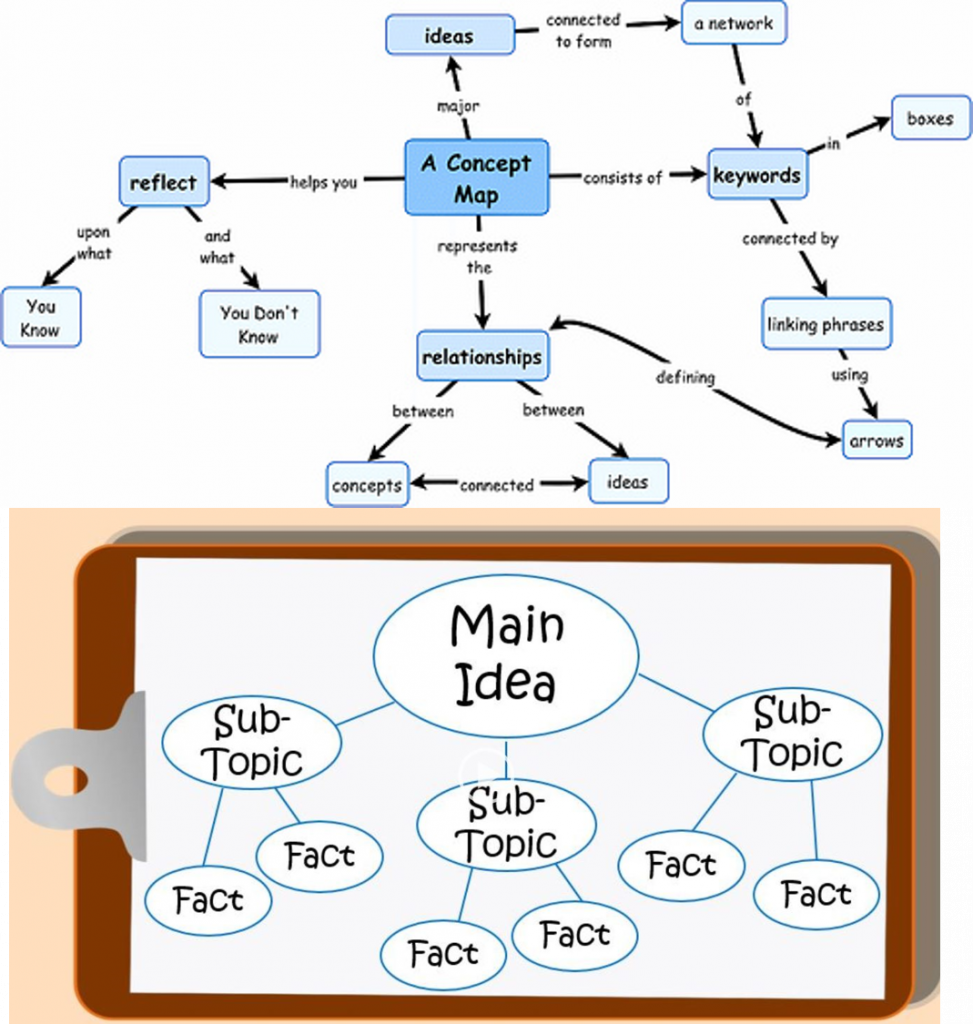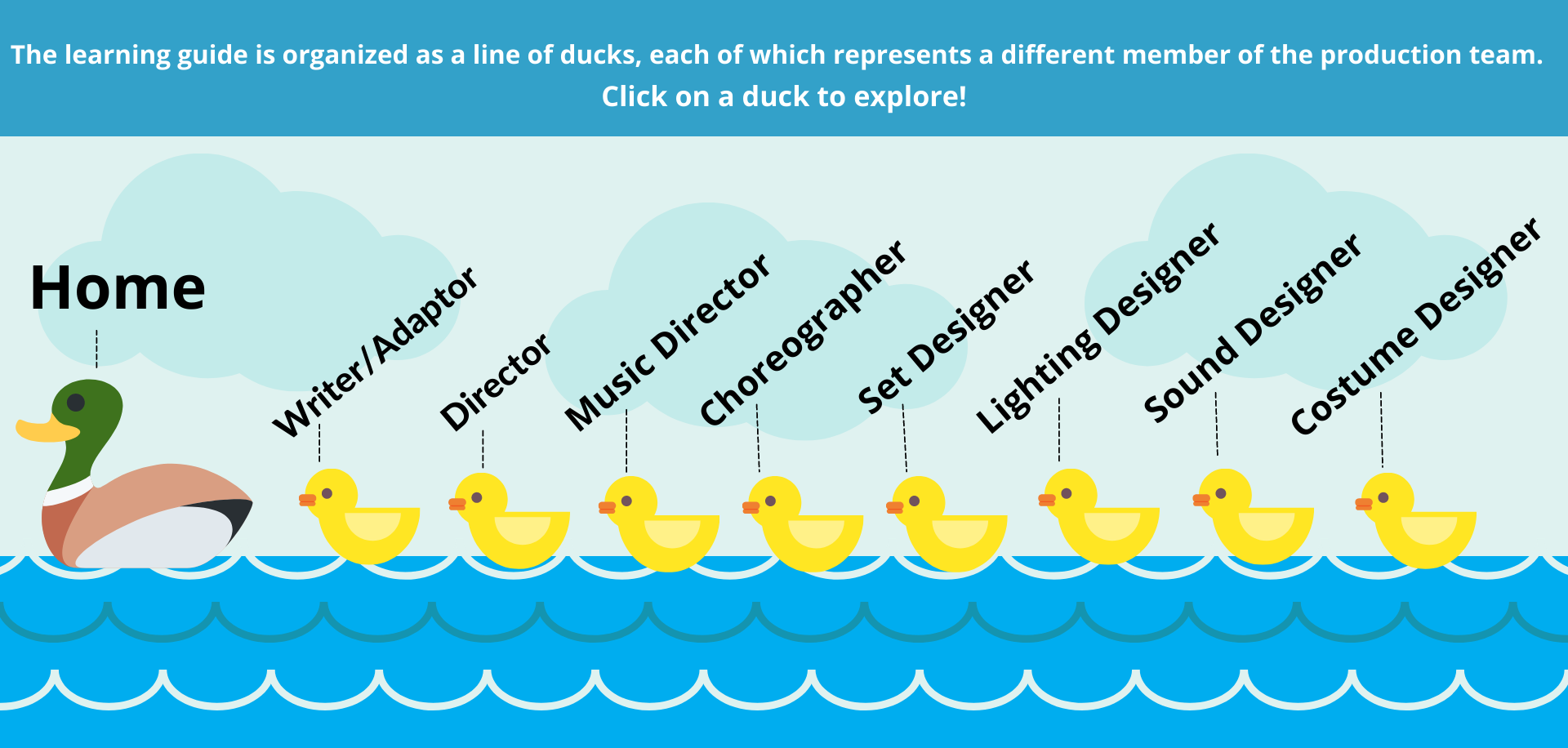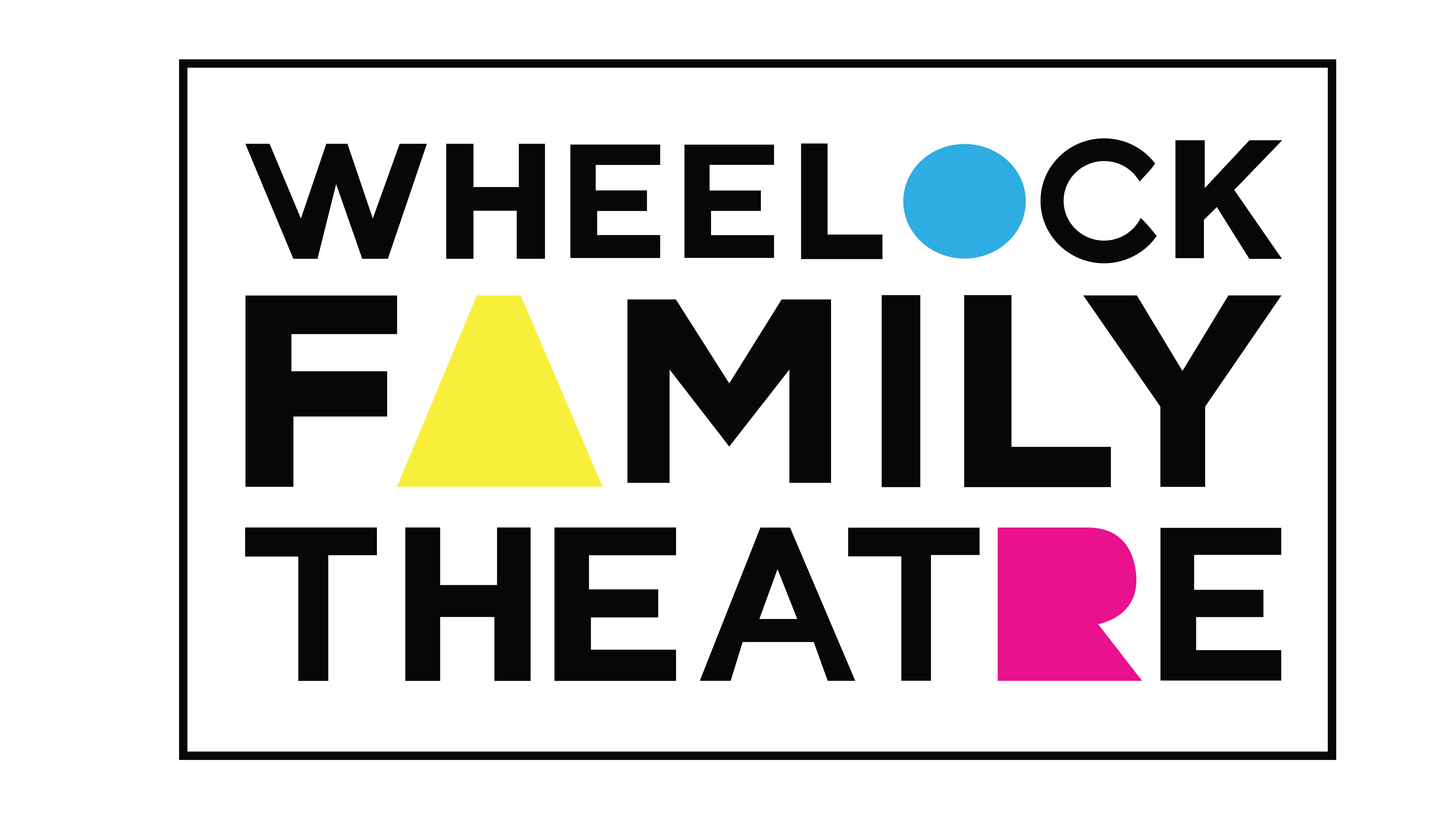
Activities are marked with the following age-range suggestions:
- EE — Early elementary (grades K-2)
- LE — Late elementary (grades 3-5)
- MS — Middle school (grades 6-8)
- HS — High school (grades 9+)
Contact Us
If you have any questions or would like to share how you and your class engaged with the VLG, send us an email at WFTEd@bu.edu.

Click through the tabs for activities and exercises
Watch an interview with Director Emily Ranii
Watch a scene in rehearsal
Watch a scene in rehearsal
Concept maps allow students to organize their thoughts about a topic, theme, or story in a visual way. Concept maps can be organized in any shape, as long as they show a student’s understanding or ideas about the topic, and the relationships between these ideas. Below are two examples of ways to organize a concept map:

Your class can make one large concept map together, which would be ideal for the youngest students, or each student can create their own individually. Begin the concept map with the name of the story, Make Way For Ducklings, as the starting point. Allow students’ understanding of the characters, setting, plot, and themes of the story to emerge as they construct their concept maps about the book/musical.
With late elementary students, ask each student to describe their concept map to another student in pairs. Then, ask students to discuss what similarities or differences arise from their concept maps and their unique understandings of the story. Consider coming together as a class after students create individual concept maps to create one large concept map on a white board or sheet of butcher paper.
With older students, use concept mapping as a way to illuminate the themes or messages that each student would want to draw out of the story if they were to direct Make Way For Ducklings. Ask your students how a concept map might be a useful tool for a director, and at what part(s) in the process a director might want to create a concept map.
If your students have never made a concept map or struggle to make meaning using concept maps, make use of the following thinking routine:
-
Generate/Sort/Connect/Elaborate (Ritchhart, Church & Morrison, 2011, p. 125)
- Generate a list of ideas, words, and thoughts that come to mind immediately
- Sort these ideas in a way that makes sense to you, or with the most central ideas in the middle
- Connect these ideas by drawing arrows or lines and describing what connects those ideas
- Elaborate further on the initial ideas, reasons for sorting, and connections you have made so far
Use the following thinking routine as a way to reflect on the impact of making a concept map for a story:
- I used to think…. about Make Way For Ducklings
- Now I think…. about Make Way For Ducklings
- So now I will…
- Ex: I used to think that Make Way For Ducklings was just about ducks. Now I think that Make Way For Ducklings is really a story about family. So now I will think about parents’ and siblings’ relationships when I read the story again.
Director Emily Ranii says that one way to start to think like a director is to consider the following: If you could use only one object onstage to tell this story, what object would you use? Why? How would you use that object, perhaps in multiple creative ways, to tell the story? You could use multiple of the same object, but they must be the same object.
Start by asking students to explore the space around them and look for objects that could be used in multiple ways to tell a story. How could a pencil be useful in multiple ways, and what message would using a pencil as the sole prop send to the audience? What about a television remote? A baseball cap? A book? An umbrella?
Next, either individually, in pairs, or in small groups, ask students to consider or discuss the themes or messages they would want to illuminate as a director when directing Make Way For Ducklings, or a different book or story that your class is reading or studying.
Students brainstorm objects that might be associated with those themes or messages.
If students are having trouble getting started, consider introducing the following thinking routine:
-
CSI: Color, Symbol, Image (Ritchhart, Church & Morrison, 2011, p. 119)
- Choose a color that represents the story
- Choose a symbol that represents the story
- Choose or sketch an image that represents the story
Now, students narrow down to two or three objects that might be top contenders to be their only one object to use in telling the story. If students can procure one of each object, they could experiment with and write down different ways that object could be a part of telling the story.
Finally, students settle on one object, and either write about or present to the class their reasoning for using that object in the story, the different ways they would use that object in the production, and the message they hope the audience takes away from the production and their creative uses of their only one object.
To reflect on this exercise, consider putting each of the objects that students chose around the classroom. Students walk around with sticky notes to each object. As they stop by each object, students write one word or sentence about how the choice of that particular object would influence their interpretation of the story as an audience member, leaving the sticky note next to the object as both reflection and feedback.
This writing exercise would be best completed after students have done some thematic exploration of the story they are working with, either through the exercises above or other avenues.
Often, a director will write a director’s note that is printed in the playbill. The director’s note shares the director’s feelings about the story, some of the ideas and choices that went into this specific production of the story, and what they hope the audience will see, learn, or take away from the production.
Each student writes a 2-3 paragraph director’s note that would go with the production that they would hope to direct — of Make Way For Ducklings or of another book or story that your class is reading or studying. Encourage students to get specific about the choices they have made in their theoretical, imaginary production, as well as to think about setting the tone for the audience members who would be reading this note before or after seeing the production.
To extend this exercise, ask students to design the cover of the playbill that would go along with their unique production of the story, and to assemble the playbill with their cover design on the front and their director’s note printed inside.
One way to share students’ work in this exercise would be to create small groups of students. One student shares their director’s note by reading it aloud, while the other students listen carefully. The listening students then respond in one of two ways: by writing down key words and phrases that they heard in that director’s note, or by drawing an image that came to mind as they listened. Listening students then give their written or drawn responses to the writer, and then the next student shares.
In this series of videos, a WFT teaching artist will introduce your students to the basics of staging. The first video focuses on the different areas of the stage.
In this series of videos, a WFT teaching artist will introduce your students to the basics of staging. The second video leads students through an exercise exploring how we use those different areas of the stage to direct the audience’s focus.
In this series of videos, a WFT teaching artist will introduce your students to the basics of staging. The third video examines how movement through the different areas of the stage communicates dynamics between characters.
Director Emily Ranii describes that a particular challenge in staging the virtual workshop of Make Way For Ducklings was representing all eight ducklings that are written into the script and from the original book. She says that, while there are four ‘major’ ducklings who speak the most and have more defined personality traits, there are four ‘minor’ ducklings as well. The play could be done with eight actors, one per duckling, or with four actors, each assigned one major duckling and one minor duckling to represent onstage, which WFT@BU’s production did.
Pose the following question to your students, after watching the virtual workshop production: How did the director solve the challenge of representing eight ducklings with only four actors? Was having each actor manipulate a sock puppet to represent their ‘minor’ duckling an effective solution for you, the audience member? Why or why not?
Next, offer the following provocation to your students: Imagine that you are a director with four actors to represent eight ducklings. What creative strategy would you employ to represent all eight ducklings onstage?
With younger groups, brainstorm ideas and then try them out all together in front of the class. The exercise could culminate in a craft, such as making sock puppets or stick puppets, as one potential solution to the challenge.
If possible, students of the age to work well in small groups should work in groups of five, giving each student a chance to experiment with their ideas using the other four students as their actors. Feel free to give students art supplies or a collection of various items to help them think outside the box.
This challenge works just as well in a virtual classroom — in fact, this more closely mirrors the way that Emily and her team had to navigate it!
Come back together and share as many solutions to the eight duckling quandary as possible!
The short scripts linked below are what we call open scenes. These brief, vague, non-specific dialogues could tell any number of stories, depending on the choices made by a director and actors.
Assign each pair of students one open scene script. After each pair reads their script out loud and assigns roles, their job is to decide on the specific story of their scene. Then, they should write out the 5 Ws — who, what, where, when, why — to explain the details of the specific story they are creating, inspired by the vague lines of the scene.
Next, without adding any words to their script, each pair must stage their scene in such a way that an audience member might be able to figure out their 5 Ws and the specific story. Students can add movement before, during, and after the lines; students can take pauses or beats during the scene, use facial expressions and physicality, convey emotion through their tone of voice, and pantomime interacting with objects to make the details of their story as clear as possible to their audience.
This exercise is a terrific opportunity for students to apply what they learned by watching the videos from Try It ACTIVITY 1: Meet The Stage!
Each pair shares their scene for their classmates twice. The first time, the group should not yet reveal the choices they have made about the 5 Ws. The audience should speculate or guess what story the group is telling after watching their performance. Then, the group can reveal their specific story, and perform again for the audience to connect their choices with their story.
This exercise can be done in-person or in a virtual classroom. As director Emily Ranii describes, staging scenes in a Zoom box can require even greater precision of movement and expression than performing in-person. An interesting experiment could be to have students re-stage on Zoom the open scenes that they already performed in-person, to understand the challenges of communicating the same story with the restrictions — or, perhaps, opportunities! — that being in a Zoom box creates.
Reflect using any or all of the following questions, or add questions of your own:
- What was fun about this exercise? What was challenging about this exercise?
- After completing this exercise, how would you define the role of a director? Did this exercise change how you understood the role of a director? If so, how?
- What tools does a director have in their metaphorical toolbox to stage a scene in order to tell a specific story?
- What is an effective movement choice you saw another group make?
- What is an effective vocal choice you heard another group make?
- How did you, or another group, apply what you learned from Try It ACTIVITY 1: Meet The Stage! in this exercise?





